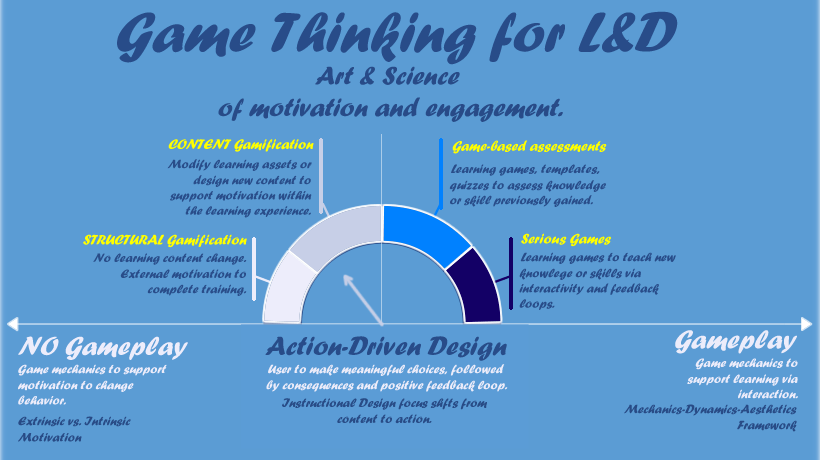Are We Asking The Right Questions When Using Game Thinking For Learning And Development?
Take a look at the Game Thinking for Learning and Development (L&D) framework above; we’ll explore various parts while analyzing why the following question has many issues on multiple levels. While putting various parts of the question under the Learning and Development microscope, we're also showing some better questions to ask.
"Isn’t Gamification Just Sugarcoating Boring eLearning Content?"
This is a closed question. Even if you could answer it, a yes or no wouldn’t help you improve on what you’re doing today. In Learning and Development we’re often good at answering questions and solving problems, but let’s make sure those are the questions to answer and the problems to solve in the first place!
Better question to ask: Am I asking the right questions?
Boring Content
Better question to ask: Why is my eLearning is boring?!
Here’s a simple test: Go through your eLearning and write down on every screen what you do as a participant: Mentally and physically. What decisions are you making? How do you interact with the course to indicate your decision? How do you get feedback on your action? What are the consequences of your actions? Drag and dropping is a user interface interaction. If it doesn’t come with a mental interaction where you need to make a meaningful decision, it’s just as bad as sugarcoating. As you can see in the framework, it’s about action-driven design where users make meaningful decisions with consequences and followed by a positive feedback loop.
When This Question Was Asked On LinkedIn, There Were Multitude Of Posts Bashing Points, Badges, And Leaderboards
Gamification is not about points, badges, and leaderboards. Gamification is about motivation. Turns out, most people identify gamification of learning with structural gamification (left end of framework), where you do not touch a learning asset, just add extrinsic motivation to encourage humans to take it.
Better questions to ask: What is my goal? What is the business goal? What behavior do I want to drive? What motivates my audience to do that behavior? What holds them back today from doing it?
Simply giving points for every comment is a very effective gamification strategy, but it motivates the wrong behavior! You’ll get lots of nonsense comments for the sake of raking in more points.
Better question to ask: How do I drive social interaction around the video content?
For example, give participants a reason to watch the video. Let participants ask questions and others answer. Let the owner of the question rank the answers! This approach drives meaningful interactions and motivates people to think.
Moving From Content To Action (Context)
Better questions to ask: How do I move from content-centric approach to action-centric approach? Participants want to know what they should do differently after the course. Okay, my course is about awareness! What then? Ask this: If person A is aware and person B is not, and they sit next to each other doing the same thing, how would you know that person A is aware? What situation would reveal that difference? That’s where you start game thinking.
"Should I Gamify The Content?"
No. Do not ever “gamify the content”. Once you nailed down the actions participants need to do (which could be invisible actions such as making decisions), then you can think about the best way to support your performance goals: Maybe gamification, maybe game-based learning, maybe game-based assessment, maybe none of them.
If you start out with the intent of gamification, you will create gamification. If you start out with the intent of game-based learning, you will create a game. This may or may not lead to the most efficient approach to achieve your goal.
Start out with Game Thinking, or gameful thinking if you wish, to approach learning problems. All the way to the left, there’s no gameplay. Participants won’t actually play a game. Gamification is about motivating them to change behavior. Structural gamification is not always bad. If you need something quick, campaign-style, one-shot event like a huddle, you can make the activity engaging quickly. As you make your way on the chart to the right, you’re making the experience more and more feel like a game.
All the way to the right, you’re building a serious-game. Designing and creating a good serious game requires skills and resources. Participants learn while they’re playing a game. Matching the right game with the that of the performance goals of your learning is a must! Read more on this in Sharon Boller and Karl Kapp’s book.
In between of these two extreme ends, you still have some options. Do you just need a quick gameful assessment, rather than learning brand new content? You may just use a game-based assessment template. Or, you may design your learning interactions to lay out progression with some engaging visual indicators how you’re doing (content gamification) without an actual gameplay.
Focus On The Experience!
In any case, always focus on the experience and not the mechanics! Asking what game mechanics should you use as a starting point is like asking what keys should you include in your next song, or what words are the best to use in a novel. It depends on your audience and the story you've got to tell. It’s about the experience.
Conclusion
The point is asking the question whether gamification is just sugarcoating boring eLearning content may not be the one you should be asking. Instead, try some of these questions above to design more engaging, gameful eLearning courses by applying Game Thinking in your next project.
Are you asking the right questions?








